20.文学术语--完整版
- 格式:doc
- 大小:65.50 KB
- 文档页数:9
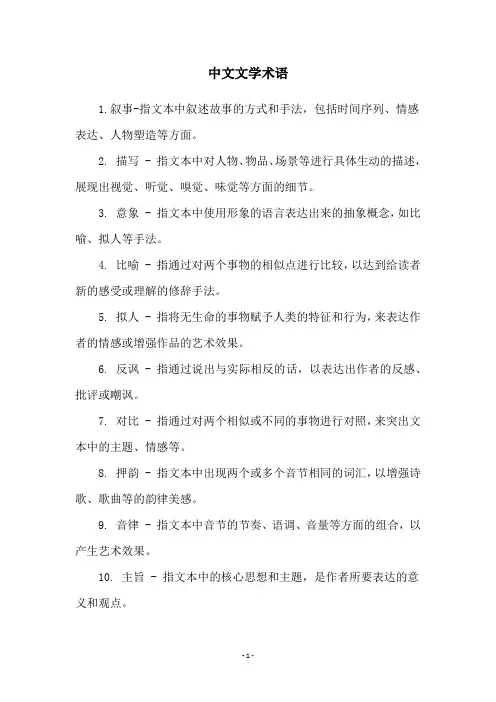
中文文学术语
1.叙事-指文本中叙述故事的方式和手法,包括时间序列、情感表达、人物塑造等方面。
2. 描写 - 指文本中对人物、物品、场景等进行具体生动的描述,展现出视觉、听觉、嗅觉、味觉等方面的细节。
3. 意象 - 指文本中使用形象的语言表达出来的抽象概念,如比喻、拟人等手法。
4. 比喻 - 指通过对两个事物的相似点进行比较,以达到给读者新的感受或理解的修辞手法。
5. 拟人 - 指将无生命的事物赋予人类的特征和行为,来表达作者的情感或增强作品的艺术效果。
6. 反讽 - 指通过说出与实际相反的话,以表达出作者的反感、批评或嘲讽。
7. 对比 - 指通过对两个相似或不同的事物进行对照,来突出文本中的主题、情感等。
8. 押韵 - 指文本中出现两个或多个音节相同的词汇,以增强诗歌、歌曲等的韵律美感。
9. 音律 - 指文本中音节的节奏、语调、音量等方面的组合,以产生艺术效果。
10. 主旨 - 指文本中的核心思想和主题,是作者所要表达的意义和观点。
- 1 -。
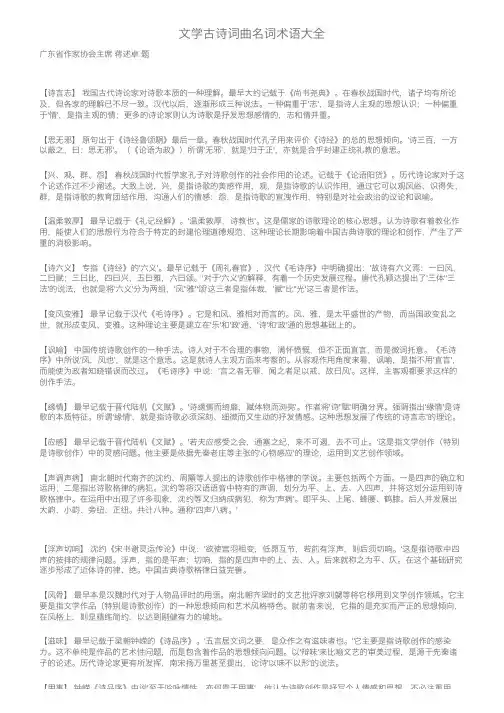
⽂学古诗词曲名词术语⼤全⼴东省作家协会主席蒋述卓题【诗⾔志】我国古代诗论家对诗歌本质的⼀种理解。
最早⼤约记载于《尚书尧典》。
在春秋战国时代,诸⼦均有所论及,但各家的理解已不尽⼀致。
汉代以后,逐渐形成三种说法。
⼀种偏重于'志',是指诗⼈主观的思想认识;⼀种偏重于'情',是指主观的情;更多的诗论家则认为诗歌是抒发思想感情的,志和情并重。
【思⽆邪】原句出于《诗经鲁颂駉》最后⼀章。
春秋战国时代孔⼦⽤来评价《诗经》的总的思想倾向。
'诗三百,⼀⽅以蔽之,⽈:思⽆邪'。
(《论语为政》)所谓'⽆邪',就是'归于正',亦就是合乎封建正统礼教的意思。
【兴、观、群、怨】春秋战国时代哲学家孔⼦对诗歌创作的社会作⽤的论述。
记载于《论语阳货》。
历代诗论家对于这个论述作过不少阐述。
⼤致上说,兴,是指诗歌的美感作⽤,观,是指诗歌的认识作⽤,通过它可以观风俗、识得失;群,是指诗歌的教育团结作⽤,沟通⼈们的情感;怨,是指诗歌的宣洩作⽤,特别是对社会政治的议论和讽喻。
【温柔敦厚】最早记载于《礼记经解》。
'温柔敦厚,诗教也'。
这是儒家的诗歌理论的核⼼思想。
认为诗歌有着教化作⽤,能使⼈们的思想⾏为符合于特定的封建伦理道德规范,这种理论长期影响着中国古典诗歌的理论和创作,产⽣了严重的消极影响。
【诗六义】专指《诗经》的'六义'。
最早记载于《周礼春官》,汉代《⽑诗序》中明确提出:'故诗有六义焉:⼀⽈风,⼆⽈赋;三⽈⽐,四⽈兴,五⽈雅,六⽈颂。
'对于'六义'的解释,有着⼀个历史发展过程。
唐代孔颖达提出了'三体''三法'的说法,也就是将'六义'分为两组,'风''雅''颂'这三者是指体裁,'赋''⽐''光'这三者是作法。
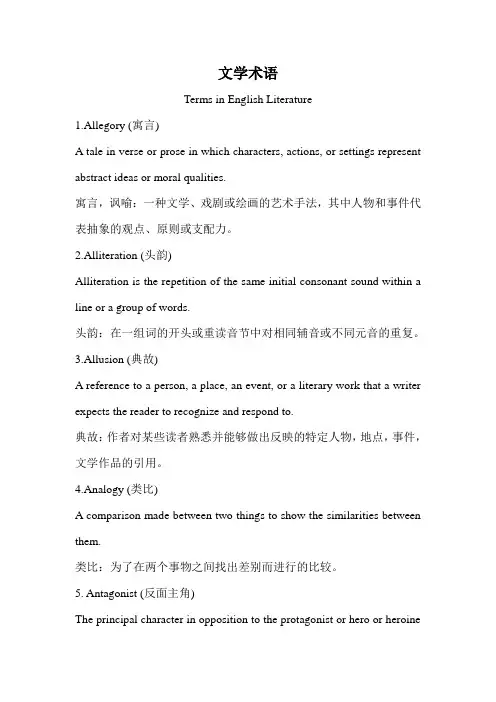
文学术语Terms in English Literature1.Allegory (寓言)A tale in verse or prose in which characters, actions, or settings represent abstract ideas or moral qualities.寓言,讽喻:一种文学、戏剧或绘画的艺术手法,其中人物和事件代表抽象的观点、原则或支配力。
2.Alliteration (头韵)Alliteration is the repetition of the same initial consonant sound within a line or a group of words.头韵:在一组词的开头或重读音节中对相同辅音或不同元音的重复。
3.Allusion (典故)A reference to a person, a place, an event, or a literary work that a writer expects the reader to recognize and respond to.典故:作者对某些读者熟悉并能够做出反映的特定人物,地点,事件,文学作品的引用。
4.Analogy (类比)A comparison made between two things to show the similarities between them.类比:为了在两个事物之间找出差别而进行的比较。
5. Antagonist (反面主角)The principal character in opposition to the protagonist or hero or heroineof a narrative or drama.反面主角:叙事文学或戏剧中与男女主人公或英雄相对立的主要人物。
6. Antithesis (对仗)The balancing of two contrasting ideas, words, or sentences.对仗:两组相对的思想,言辞,词句的平衡。
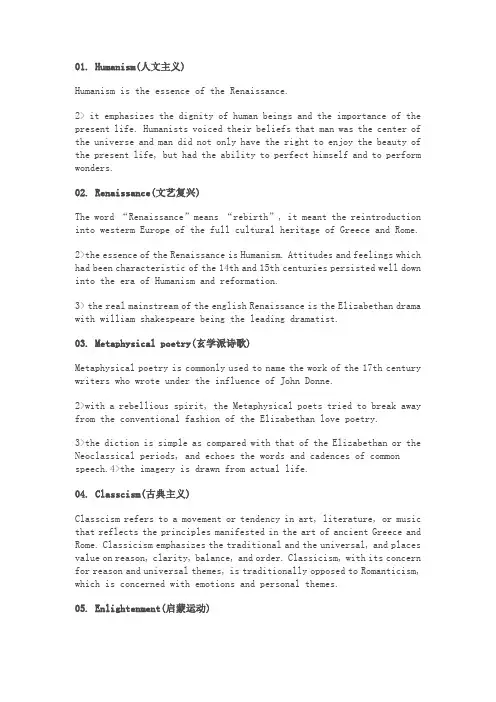
01. Humanism(人文主义)Humanism is the essence of the Renaissance.2> it emphasizes the dignity of human beings and the importance of the present life. Humanists voiced their beliefs that man was the center of the universe and man did not only have the right to enjoy the beauty of the present life, but had the ability to perfect himself and to perform wonders.02. Renaissance(文艺复兴)The word “Renaissance”means “rebirth”, it meant the reintroduction into westerm Europe of the full cultural heritage of Greece and Rome.2>the essence of the Renaissance is Humanism. Attitudes and feelings which had been characteristic of the 14th and 15th centuries persisted well down into the era of Humanism and reformation.3> the real mainstream of the english Renaissance is the Elizabethan drama with william shakespeare being the leading dramatist.03. Metaphysical poetry(玄学派诗歌)Metaphysical poetry is commonly used to name the work of the 17th century writers who wrote under the influence of John Donne.2>with a rebellious spirit, the Metaphysical poets tried to break away from the conventional fashion of the Elizabethan love poetry.3>the diction is simple as compared with that of the Elizabethan or the Neoclassical periods, and echoes the words and cadences of common speech.4>the imagery is drawn from actual life.04. Classcism(古典主义)Classcism refers to a movement or tendency in art, literature, or music that reflects the principles manifested in the art of ancient Greece and Rome. Classicism emphasizes the traditional and the universal, and places value on reason, clarity, balance, and order. Classicism, with its concern for reason and universal themes, is traditionally opposed to Romanticism, which is concerned with emotions and personal themes.05. Enlightenment(启蒙运动)Enlightenment movement was a progressive philosophical and artistic movement which flourished in france and swept through western Europe in the 18th century.2> the movement was a furtherance of the Renaissance from 14th century to the mid-17th century.3>its purpose was to enlighten the whole world with the light of modern philosophical and artistic ideas.4>it celebrated reason or rationality, equality and science. It advocated universal education.5>famous among the great enlighteners in england were those great writers like Alexander pope. Jonathan swift.etc.06.Neoclassicism(新古典主义)In the field of literature, the enlightenment movement brought about a revival of interest in the old classical works.2>this tendency is known as neoclassicism. The Neoclassicists held that forms of literature were to be modeled after the classical works of the ancient Greek and Roman writers such as Homer and Virgil and those of the contemporary French ones.3> they believed that the artistic ideals should be order, logic, restrained emotion and accuracy, and that literature should be judged in terms of its service to humanity.07. The Graveyard School(墓地派诗歌)The Graveyard School refers to a school of poets of the 18th century whose poems are mostly devoted to a sentimental lamentation or meditation on life. Past and present, with death and graveyard as themes.2>Thomas Gray is considered to be the leading figure of this school and his Elegy written in a country churchyard is its most representative work.08. Romanticism(浪漫主义)1>In the mid-18th century, a new literary movement called romanticism came to Europe and then to England.2>It was characterized by a strong protest against the bondage of neoclassicism, which emphasized reason, order and elegant wit. Instead, romanticism gave primary concern to passion, emotion, and natural beauty.3>In the history of literature. Romanticism is generally regarded as the thought that designates a literary and philosophical theory which tends to see the individual as the very center of all life and experience. 4> The English romantic period is an age of poetry which prevailed in England from 1798 to 1837. The major romantic poets include Wordsworth, Byron and Shelley.09. Byronic Hero(拜伦式英雄)Byronic hero refers to a proud, mysterious rebel figure of noble origin.2> with immense superiority in his passions and powers, this Byronic Hero would carry on his shoulders the burden of righting all the wrongs in a corrupt society. And would rise single-handedly against any kind of tyrannical rules either in government, in religion, or in moral principles with unconquerable wills and inexhaustible energies.3> Byron’s chief contr ibution to English literature is his creation of the “Byronic Hero”10. Critical Realism(批判现实主义)Critical Realism is a term applied to the realistic fiction in the late 19th and early 20th centuries.2> It means the tendency of writers and intellectuals in the period between 1875 and 1920 to apply the methods of realistic fiction to the criticism of society and the examination of social issues.3> Realist writers were all concerned about the fate of the common people and described what was faithful to reality.4> Charles Dickens is the most important critical realist.11. Aestheticism(美学主义)The basic theory of the Aesthetic movement--- “art for art’s sake” was set forth by a French poet, Theophile Gautier, the first Englishman who wrote about the theory of aestheticism was Walter Pater.2> aestheticism places art above life, and holds that life should imitate art, not art imitate life.3> According to the aesthetes, all artistic creation is absolutely subjective as opposed to objective. Art should be free from any influence of egoism. Only when art is for art’s sake, can it be immortal. They believed that art should be unconcerned with controversial issues, such as politics and morality, and that it should be restricted to contributing beauty in a highly polished style.4> This is one of the reactions against the materialism and commercialism of the Victorian industrial era, as well as a reaction against the Victorian convention of art for morality’s sake, or art for money’s sake.美学运动的基本原则”为艺术而艺术”最初由法国诗人西奥费尔.高缔尔提出,英国运用该美学理论的第一人是沃尔特.佩特.美学主义崇尚艺术高于生活,认为生活应模仿艺术,而不是艺术模仿生活.在美学主义看来,所有的艺术创作都是绝对主观而非客观的产物.艺术不应受任何功利的影响,只有当艺术为艺术而创作时,艺术才能成为不朽之作.他们还认为艺术不应只关注一些热点话题如政治和道德问题,艺术应着力于以华丽的风格张扬美.这是对维多利亚工业发展时期物质崇拜的一种回应,也是向艺术为道德或为金钱而服务的维多利亚传统的挑战.12.The Victorian period(维多利亚时期)In this period, the novel became the most widely read and the most vital and challenging expression of progressive thought. While sticking to the principle of faithful representation of the 18th century realist novel, novelists in this period carried their duty forward to criticism of the society and the defense of the mass.2> although writing from different points of view and with different techniques, they shared one thing in common, that is, they were all concerned about the fate of the common people. They were angry with the inhuman social institutions, the decaying social morality as represented by the money-worship and Utilitarianism, and the widespread misery, poverty and injustice.3>their truthful picture of people’s life and bitter and strong criticism of the society had done much in awakening the public consciousness to the social problems and in the actual improvement of the society.4> Charles Dickens is the leading figure of the Victorian period.13. Modernism(现代主义)Modernism is comprehensive but vague term for a movement , which begin in the late 19th century and which has had a wide influence internationally during much of the 20th century.2> modernism takes the irrational philosophy and the theory ofpsycho-analysis as its theoretical case.3> the term pertains to all the creative arts. Especially poetry, fiction, drama, painting, music and architecture.4> in England from early in the 20th century and during the 1920s and 1930s, in America from shortly before the first world war and on during the inter-war period, modernist tendencies were at their most active and fruitful.5>as far as literature is concerned, Modernism reveals a breaking away from established rules, traditions and conventions, the fresh ways of lo oking at man’s position and function in the universe and many experiments in form and style. It is particularly concerned with language and how to use it and with writing itself.14. Stream of consciousness(意识流)(or interior monologue)In literary criticism, Stream of consciousness denotes a literary technique which seeks to describe an individual’s point of view by giving the written equivalent of the character’s thought processes. Stream of consciousness writing is strongly associated with the modernist movement. Its introduction in the literary context, transferred from psychology, hhhyis attributed to May Sinclair. Stream of consciousness writing is usually regarded as a special form of interior monologue and is characterized by associative leaps in syntax and punctuation that can make the prose difficult to follow, tracing as they do a character’s fragmentary thoughts and sensory feelings. Famous writers to employ this technique in the English language include James Joyce and William Faulkner.学术界认为意识流是一种通过直接描述人物思维过程来寻求个人视角的文学写作技巧。
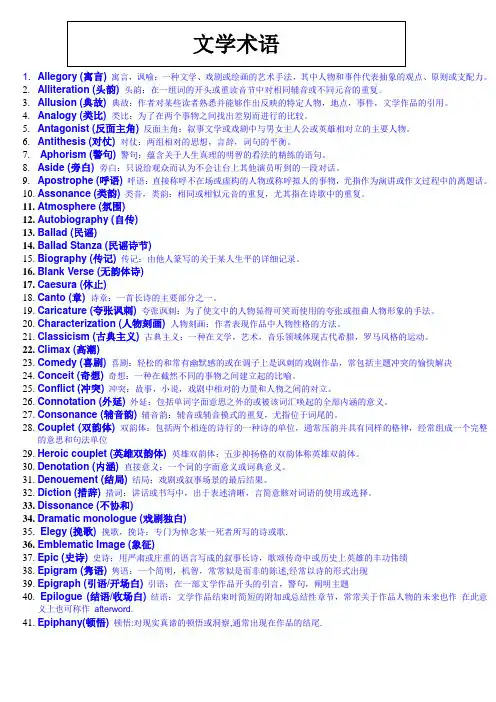
1. Allegory (寓言)寓言,讽喻:一种文学、戏剧或绘画的艺术手法,其中人物和事件代表抽象的观点、原则或支配力。
2.Alliteration (头韵) 头韵:在一组词的开头或重读音节中对相同辅音或不同元音的重复。
3.Allusion (典故) 典故:作者对某些读者熟悉并能够作出反映的特定人物,地点,事件,文学作品的引用。
4.Analogy (类比) 类比:为了在两个事物之间找出差别而进行的比较。
5.Antagonist (反面主角)反面主角:叙事文学或戏剧中与男女主人公或英雄相对立的主要人物。
6.Antithesis (对仗) 对仗:两组相对的思想,言辞,词句的平衡。
7. Aphorism (警句)警句:蕴含关于人生真理的明智的看法的精练的语句。
8.Aside (旁白) 旁白:只说给观众而认为不会让台上其他演员听到的一段对话。
9.Apostrophe (呼语)呼语:直接称呼不在场或虚构的人物或称呼拟人的事物,尤指作为演讲或作文过程中的离题话。
10.Assonance (类韵)类音,类韵:相同或相似元音的重复,尤其指在诗歌中的重复。
11.Atmosphere (氛围)12.Autobiography (自传)13.Ballad (民谣)14.Ballad Stanza (民谣诗节)15.Biography (传记)传记:由他人篆写的关于某人生平的详细记录。
16.Blank Verse (无韵体诗)17.Caesura (休止)18.Canto (章) 诗章:一首长诗的主要部分之一。
19.Caricature (夸张讽刺) 夸张讽刺:为了使文中的人物显得可笑而使用的夸张或扭曲人物形象的手法。
20.Characterization (人物刻画) 人物刻画:作者表现作品中人物性格的方法。
21.Classicism (古典主义) 古典主义:一种在文学,艺术,音乐领域体现古代希腊,罗马风格的运动。
22.Climax (高潮)edy (喜剧)喜剧:轻松的和常有幽默感的或在调子上是讽刺的戏剧作品,常包括主题冲突的愉快解决24.Conceit (奇想)奇想:一种在截然不同的事物之间建立起的比喻。
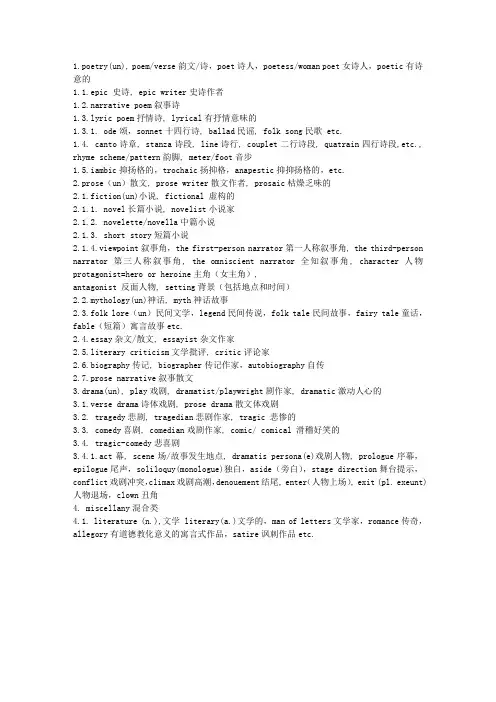
1.poetry(un), poem/verse韵文/诗,poet诗人,poetess/woman poet女诗人,poetic有诗意的1.1.epic 史诗, epic writer史诗作者1.2.narrative poem叙事诗1.3.lyric poem抒情诗, lyrical有抒情意味的1.3.1. ode颂,sonnet十四行诗, ballad民谣, folk song民歌 etc.1.4. canto诗章, stanza诗段, line诗行, couplet二行诗段, quatrain四行诗段,etc., rhyme scheme/pattern韵脚, meter/foot音步1.5.iambic抑扬格的,trochaic扬抑格,anapestic抑抑扬格的,etc.2.prose(un)散文, prose writer散文作者, prosaic枯燥乏味的2.1.fiction(un)小说, fictional 虚构的2.1.1. novel长篇小说, novelist小说家2.1.2. novelette/novella中篇小说2.1.3. short story短篇小说2.1.4.viewpoint叙事角,the first-person narrator第一人称叙事角, the third-person narrator第三人称叙事角, the omniscient narrator全知叙事角, character人物protagonist=hero or heroine主角(女主角),antagonist 反面人物, setting背景(包括地点和时间)2.2.mythology(un)神话, myth神话故事2.3.folk lore(un)民间文学,legend民间传说,folk tale民间故事,fairy tale童话,fable(短篇)寓言故事etc.2.4.essay杂文/散文, essayist杂文作家2.5.literary criticism文学批评, critic评论家2.6.biography传记, biographer传记作家,autobiography自传2.7.prose narrative叙事散文3.drama(un), play戏剧, dramatist/playwright剧作家, dramatic激动人心的3.1.verse drama诗体戏剧, prose drama散文体戏剧3.2. tragedy悲剧, tragedian悲剧作家, tragic 悲惨的3.3. comedy喜剧, comedian戏剧作家, comic/ comical 滑稽好笑的3.4. tragic-comedy悲喜剧3.4.1.act幕, scene场/故事发生地点, dramatis persona(e)戏剧人物, prologue序幕,epilogue尾声,soliloquy(monologue)独白,aside(旁白),stage direction舞台提示,conflict戏剧冲突,climax戏剧高潮,denouement结尾, enter(人物上场), exit (pl. exeunt)人物退场,clown丑角4. miscellany混合类4.1. literature (n.),文学 literary(a.)文学的,man of letters文学家,romance传奇,allegory有道德教化意义的寓言式作品,satire讽刺作品etc.。

中国文学术语集
以下是一些中国文学术语的集合:
1. 诗歌体裁:
- 诗:表达情感、描绘景物和抒发思想的文学形式。
- 词:以短小精悍的形式表达情感的文学形式。
- 曲:以歌唱为主的文学形式。
- 赋:以描写或抒发感情为主的文学形式。
2. 修辞手法:
- 比喻:用一种事物来比喻另一种事物,以增强表达的艺术性和形象性。
- 拟人:赋予非人物以人的特征和行为,增加情感共鸣。
- 夸张:夸大事物的特征或程度,以增强表达的效果。
- 排比:通过列举相同结构的词语或短语来加强表达的力度。
3. 修辞格:
- 对偶:用相同或相似的词语、短语或句子结构来表达对立或相反的意思。
- 反问:用疑问句的形式来表达肯定或否定的意思。
- 押韵:在诗歌中使用相同或相似的音韵来增加韵律感。
4. 现象:
- 平仄:指汉字的声调高低变化。
- 押韵:在诗歌中使用相同或相似的音韵来增加韵律感。
- 韵律:诗歌中的节奏和音乐感。
5. 文学流派:
- 唐诗:盛行于唐朝的诗歌形式,以七言绝句为主要形式。
- 宋词:盛行于宋朝的短小精悍的诗歌形式。
- 元曲:盛行于元朝的戏剧形式,以曲子和对白相结合的形式。
这只是一些中国文学术语的集合,还有许多其他的术语和概念,用于描述和分析中国文学作品和文学创作的特点和风格。
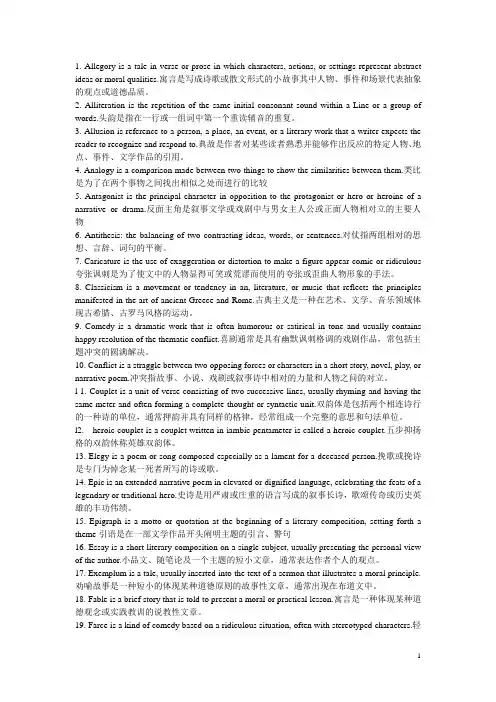
1. Allegory is a tale in verse or prose in which characters, actions, or settings represent abstract ideas or moral qualities.寓言是写成诗歌或散文形式的小故事其中人物、事件和场景代表抽象的观点或道德品质。
2. Alliteration is the repetition of the same initial consonant sound within a Line or a group of words.头韵是指在一行或一组词中第一个重读辅音的重复。
3. Allusion is reference to a person, a place, an event, or a literary work that a writer expects the reader to recognize and respond to.典故是作者对某些读者熟悉并能够作出反应的特定人物、地点、事件、文学作品的引用。
4. Analogy is a comparison made between two things to show the similarities between them.类比是为了在两个事物之间找出相似之处而进行的比较5. Antagonist is the principal character in opposition to the protagonist or hero or heroine of a narrative or drama.反面主角是叙事文学或戏剧中与男女主人公或正面人物相对立的主要人物6. Antithesis: the balancing of two contrasting ideas, words, or sentences.对仗指两组相对的思想、言辞、词句的平衡。
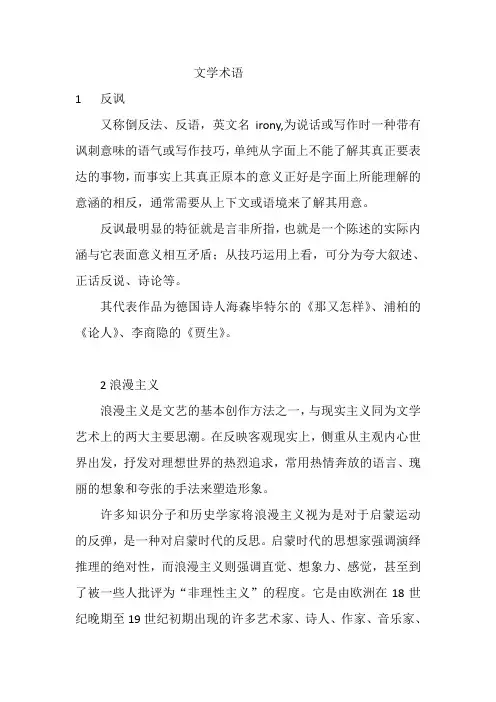
文学术语1 反讽又称倒反法、反语,英文名irony,为说话或写作时一种带有讽刺意味的语气或写作技巧,单纯从字面上不能了解其真正要表达的事物,而事实上其真正原本的意义正好是字面上所能理解的意涵的相反,通常需要从上下文或语境来了解其用意。
反讽最明显的特征就是言非所指,也就是一个陈述的实际内涵与它表面意义相互矛盾;从技巧运用上看,可分为夸大叙述、正话反说、诗论等。
其代表作品为德国诗人海森毕特尔的《那又怎样》、浦柏的《论人》、李商隐的《贾生》。
2浪漫主义浪漫主义是文艺的基本创作方法之一,与现实主义同为文学艺术上的两大主要思潮。
在反映客观现实上,侧重从主观内心世界出发,抒发对理想世界的热烈追求,常用热情奔放的语言、瑰丽的想象和夸张的手法来塑造形象。
许多知识分子和历史学家将浪漫主义视为是对于启蒙运动的反弹,是一种对启蒙时代的反思。
启蒙时代的思想家强调演绎推理的绝对性,而浪漫主义则强调直觉、想象力、感觉,甚至到了被一些人批评为“非理性主义”的程度。
它是由欧洲在18世纪晚期至19世纪初期出现的许多艺术家、诗人、作家、音乐家、以及政治家、哲学家等各种人物组成,其详细特征和定义一直到20世纪都仍是思想史和文学史界争议的题材。
其特征主要有:1 偏重于表现主观理想,抒发强烈的个人感情;2 描写自然风光,歌颂大自然;3 酷爱描写中世纪和以往的历史;4 重视民间文学,尤其是中世纪民间文学。
其代表是布莱克、华兹华斯《抒情歌妖姬》、科勒律治、拜伦、雪莱《西风颂》、普希金、贝多芬《第五交响曲》、肖邦、雨果《悲惨世界》、欧文《睡谷传说》、麦尔维尔《白鲸》、司格特《艾凡赫》、屈原《离骚》、李白《将进酒》、郭沫若3 清教主义清教主义起源于英国,在北美得以实践和发展。
其因信称义、天职思想、山巅之城等核心理念虽然构成宗教行为规范要素,却在很大程度上起到了消解禁锢人们思想和行为的主流教会传统的作用,促进了社会世俗化进程。
在早期的美国,推动力个性解放,促成建立现代劳动、职业和财富观,以宗教的理想勾勒出国家未来追求的目标。
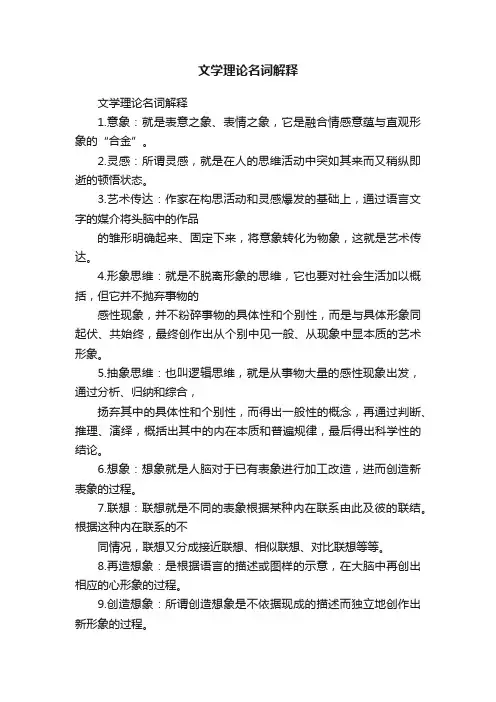
文学理论名词解释文学理论名词解释1.意象:就是表意之象、表情之象,它是融合情感意蕴与直观形象的“合金”。
2.灵感:所谓灵感,就是在人的思维活动中突如其来而又稍纵即逝的顿悟状态。
3.艺术传达:作家在构思活动和灵感爆发的基础上,通过语言文字的媒介将头脑中的作品的雏形明确起来、固定下来,将意象转化为物象,这就是艺术传达。
4.形象思维:就是不脱离形象的思维,它也要对社会生活加以概括,但它并不抛弃事物的感性现象,并不粉碎事物的具体性和个别性,而是与具体形象同起伏、共始终,最终创作出从个别中见一般、从现象中显本质的艺术形象。
5.抽象思维:也叫逻辑思维,就是从事物大量的感性现象出发,通过分析、归纳和综合,扬弃其中的具体性和个别性,而得出一般性的概念,再通过判断、推理、演绎,概括出其中的内在本质和普遍规律,最后得出科学性的结论。
6.想象:想象就是人脑对于已有表象进行加工改造,进而创造新表象的过程。
7.联想:联想就是不同的表象根据某种内在联系由此及彼的联结。
根据这种内在联系的不同情况,联想又分成接近联想、相似联想、对比联想等等。
8.再造想象:是根据语言的描述或图样的示意,在大脑中再创出相应的心形象的过程。
9.创造想象:所谓创造想象是不依据现成的描述而独立地创作出新形象的过程。
10.文学风格:从本质上说,是主观与客观、内容与形式相互交融的有机融合体,它是作家在主观方面的个人独特性在创造过程及其物化的成果--作品中的体现,它不但在作品的形式上,而且也在作品的内容上表象出来。
11.“风格即人”:是18世纪法国学者布封在《论风格》的演说中提出来的命题,即风格必须一人为本,以人的主观精神修养为根底,包括人的道德、品格、情感等。
是作家个性在文学作品中的体现,是作家的创造个性与具体话语情景造成的相对稳定的整体话语特色。
12.文学流派:就是一批在思想倾向、美学观念、文学主张等方面相互趋同或接近的作家自觉或不自觉地形成的文学派别,他们在实际创作中往往表现出艺术特色和风格追求的一致性。
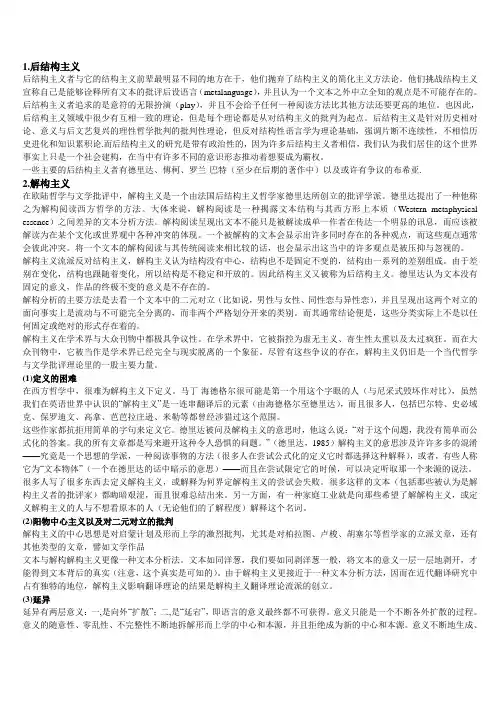
1.后结构主义后结构主义者与它的结构主义前辈最明显不同的地方在于,他们抛弃了结构主义的简化主义方法论。
他们挑战结构主义宣称自己是能够诠释所有文本的批评后设语言(metalanguage),并且认为一个文本之外中立全知的观点是不可能存在的。
后结构主义者追求的是意符的无限扮演(play),并且不会给予任何一种阅读方法比其他方法还要更高的地位。
也因此,后结构主义领域中很少有互相一致的理论,但是每个理论都是从对结构主义的批判为起点。
后结构主义是针对历史相对论、意义与后文艺复兴的理性哲学批判的批判性理论,但反对结构性语言学为理论基础,强调片断不连续性,不相信历史进化和知识累积论.而后结构主义的研究是带有政治性的,因为许多后结构主义者相信,我们认为我们居住的这个世界事实上只是一个社会建构,在当中有许多不同的意识形态推动着想要成为霸权。
一些主要的后结构主义者有德里达、傅柯、罗兰·巴特(至少在后期的著作中)以及或许有争议的布希亚.2.解构主义在欧陆哲学与文学批评中,解构主义是一个由法国后结构主义哲学家德里达所创立的批评学派。
德里达提出了一种他称之为解构阅读西方哲学的方法。
大体来说,解构阅读是一种揭露文本结构与其西方形上本质(Western metaphysical essence)之间差异的文本分析方法。
解构阅读呈现出文本不能只是被解读成单一作者在传达一个明显的讯息,而应该被解读为在某个文化或世界观中各种冲突的体现。
一个被解构的文本会显示出许多同时存在的各种观点,而这些观点通常会彼此冲突。
将一个文本的解构阅读与其传统阅读来相比较的话,也会显示出这当中的许多观点是被压抑与忽视的。
解构主义流派反对结构主义,解构主义认为结构没有中心,结构也不是固定不变的,结构由一系列的差别组成。
由于差别在变化,结构也跟随着变化,所以结构是不稳定和开放的。
因此结构主义又被称为后结构主义。
德里达认为文本没有固定的意义,作品的终极不变的意义是不存在的。
文学理论基本术语1. 文学四要素。
这是由美国批评家艾布拉姆斯(M.H. Abrams)在《镜与灯——浪漫主义文论及批评传统》提出的观点,认为文学活动由世界、作者、作品和读者四要素组成。
2. 模仿说。
这是古希腊有关文艺起源的学说,认为文艺起源于人对宇宙事物的模仿。
它内部存在两种对立观念,一种是以柏拉图为代表的否定性模仿说,认为艺术仅仅模仿世界的“影子的影子”,因而没有真理价值;另一种是以亚里士多德为代表的肯定性模仿说,与柏拉图的主张相反,认为艺术模仿世界同样能达到真理境界,这一主张后来成为现实主义文艺观的圭臬。
3. 观物取象说。
这是中国古代有关文艺起源的学说,认为文艺的起源与人“观”天地鸟兽的运动变化并加以模仿的行为有关。
4. 表现说。
这是西方18世纪以来随浪漫主义思潮而形成的学说,认为文学是作者心灵或情感的表现。
5. 言志说。
这是中国先秦产生的学说,认为诗歌是作者情感和志向的表现。
6. 文学本体论。
这是美国批评家兰塞姆(J. C. Ransom)提出的观点,认为文学活动的本体在于文学作品而不是外在的世界或作者。
作为本体的作品并不是指传统理论中作品的内容或是内容与形式的统一,而是仅仅指作品的形式。
7. 劳动说。
有关文学起源于劳动的学说,认为文学活动得以发生的根本原因是人类最基本的活动——劳动。
第一,劳动提供了文学活动的前提条件。
第二,劳动摧发了文学活动的需要,提供了文学的主要内容。
第三,在文学的早期形式上也体现了劳动的痕迹。
8. 不平衡说。
这是马克思恩格斯提出的有关艺术生产与物质生产之间关系的学说,认为艺术活动的发展与人类生产劳动的发展并不总是同步,或快或慢,有时甚至呈反方向发展。
这种“不平衡”有两种典范性表现:一种是某些文艺类型如神话和史诗只能兴盛于生产发展相对低级的阶段;另一种则是艺术生产与物质生产的发展水平不是呈正比例,经济落后的国家和地区可能在艺术上反而领先。
9. 循环说。
这是加拿大批评家弗莱(N. Frye)提出的有关文学发展动因的学说,认为文学的变化与自然节律相似,呈现出有规律的更替与循环过程,黎明和春天与喜剧对应,日午和夏天与传奇对应,日落和秋天与悲剧对应,黑暗和冬天与讽刺文学对应。
高二英语文学作品分析术语表1. 幽默(Humor):用于在文学作品中创造笑料和引起观众开心的技巧或手法。
2. 叙述(Narration):将事件或情节以一定的方式进行组织和呈现的行为。
3. 描写(Description):使用生动的语言和艺术手法来刻画人物、情节、地点等的行为。
4. 比喻(Metaphor):通过将一个事物与另一个看似不相关的事物进行类比,以便传达一种隐喻意义的修辞手法。
5. 暗示(Foreshadowing):用于提前暗示或预示故事中将要发生的事情的技巧,常常给读者留下悬念。
6. 反讽(Irony):意指事与愿违的情况,或言外之意与表面意思相反的修辞手法。
7. 对比(Contrast):通过展示两个或多个事物之间的差异,以突出其中之一的技巧。
8. 转折(Plot twist):在故事中出现的出人意料的事件或情节发展,能够给故事增添戏剧性和悬念。
9. 水墨(Ink wash):一种以水和墨汁为主要材料的绘画技巧,常用于描绘中国山水画或传统人物画中。
10. 反派角色(Antagonist):故事中与主人公发生冲突或是主要阻碍主人公实现目标的角色。
11. 意象(Imagery):通过艺术化的文字描述,使读者能够感觉到故事中的画面、声音、味道、触感等。
12. 主题(Theme):文学作品或故事中探讨的中心思想、观点或教训。
13. 隐喻(Symbolism):使用一个事物来代表另一个或多个更深远的含义的修辞手法。
14. 直喻(Simile):通过明确地使用“像”或其他比较性词语来进行比较的修辞手法。
15. 快节奏(Fast-paced):用来描述故事发展迅速,情节紧凑,节奏感强的作品。
16. 指代(Reference):通过使用代词或其他词语来指代先前已提及的事物。
17. 情感描写(Emotional description):描述人物内心感受或情绪状态的文学技巧。
18. 反英雄(Anti-hero):具有明显缺点或矛盾性格的主人公角色。
1.Alliteration:2.American Renaissance:3.Blank verse:edy:5.Enlightenment:6.Free verse:7.Genre:8.Gothic novel:9.Heroic couplet:10.Irony:11.Motif and theme:12.Plot:13.Point of view:14.Pun:15.Puritanism:16.Rhyme:17.Setting:18.Stanza:19.Style20.Transcendentalism in America以上是本次期末考试的文学术语范围,答案在我发给大家的艾布拉姆斯文学术语书里找,但是孩子们,不要死记硬背,比如说Enlightenment这个词,它的英文解释如下:The name applied to an intellectual movement and culturalambiance which developed in western Europe during the seventeenthcentury and reached its height in the eighteenth. The common element was atrust in human reason as adequate to solve the crucial problems and to establishthe essential norms in life, together with the belief that the application ofreason was rapidly dissipating the darkness of superstition, prejudice, and barbarity,was freeing humanity from its earlier reliance on mere authority andunexamined tradition, and had opened the prospect of progress toward a lifein this world of universal peace and happiness. (See the idea of progress.) Forsome thinkers the model for "reason" was the inductive procedure of science,76 EPICwhich proceeds by reasoning from the facts of experience to general laws; forothers (especially Descartes and his followers), the model for "reason" was primarily geometrical—the deduction of particular truths from clear and distinctideas which are known intuitively, by "the light of reason." Many thinkers reliedon reason in both these senses.In England the thought and the world outlook of the Enlightenmentare usually traced from Francis Bacon (1561-1626) through John Locke(1632-1704) to late-eighteenth-century thinkers such as William Godwin; inFrance, from Descartes (1596-1650) through Voltaire (1694-1778) to Diderotand other editors of the great twenty-volume Encyclopédie (1751-72); in Germany,from Leibniz (1646-1716) to what is often said to be the highest productof the Enlightenment, the "critical philosophy" of Immanuel Kant(1724-1804). Kant's famous essay "What Is Enlightenment?" written in 1784,defines it as "the liberation of mankind from his self-caused state of minority"and the achievement of a state of maturity which is exemplified in his "determinationand courage to use [his understanding] without the assistance of another."In America, Benjamin Franklin and Thomas Jefferson represented theprinciples of the French and English Enlightenment, which also helped shapethe founding documents of the United States, the Declaration of Independenceand the Constitution.See neoclassicism and romanticism; and refer to Ernst Cassirer, The Philosophyof the Enlightenment (1932); A. O. Lovejoy, Essays in the History of Ideas(1948); Basil Willey, The Eighteenth Century Background (1950); Peter Gay, The Enlightenment: An Interpretation (196标记黄色的第一部分是对这个术语的解释,因为我们是在美国文学中接触这个术语,所以在答题的时候需要提一下美国的Enlightenment period, 标记黄色的第二部分就是对这个术语美国情况的进一步阐释。
1、知我者,谓我心忧,不知我者,谓我何求。
(诗经王风黍离)2、人而无仪,不死何为。
(诗经风相鼠)3、言者无罪,闻者足戒。
(诗经大序)4、他山之石,可以攻玉。
(诗经小雅鹤鸣)5、投我以桃,报之以李。
(诗经大雅抑)6、天作孽,犹可违,自作孽,不可活。
(尚书)7、满招损,谦受益。
(尚书大禹谟)8、从善如登,从恶如崩。
(国语)9、多行不义必自毙。
(左传)10、居安思危,思则有备,有备无患。
(左传)11、人非圣贤,孰能无过?过而能改,善莫大焉。
(左传)12、知人者智,自知者明。
(老子)13、信言不美,美言不信。
(老子)14、祸兮福之所倚,福兮祸之所伏。
(老子)15、合抱之木,生于毫末;九层之台,起于累土;千里之行,始于足下。
(老子)16、敏而好学,不耻下问。
(论语公冶长)17、己所不欲,勿施于人。
(论语颜渊)18、工欲善其事,必先利其器。
(论语卫灵公)19、君子坦荡荡,小人长戚戚。
(论语述而)20、岁寒,然后知松柏之后凋也。
(论语子罕)21、学而不思则罔,思而不学则殆。
(论语为政)22、知者不惑,仁者不忧,勇者不惧。
(论语子罕)23、人谁无过?过而能改,善莫大焉。
(论语)24、知之为知之,不知为不知,是知也。
(论语为政)25、知之者不如好之者,好之者不如乐之者。
(论语雍也)26、其身正,不令而行;其身不正,虽令不从。
(论语子路)27、三人行,必有我师焉:择其善而从之,其不善者而改之。
(论语述而)28、大道之行,天下为公。
(礼记礼运)29、凡事预则立,不预则废。
(礼记中庸)30、学然后知不足,教然后知困。
(礼记学记)31、玉不琢,不成器;人不学,不知道。
(礼记学记)32、路漫漫其修远兮,吾将上下而求索。
(屈原离骚)33、尺有所短,寸有所长。
(楚辞卜居)34、尽信书,不如无书。
(孟子尽心下)35、生于忧患,死于安乐。
(孟子告子下)36、得道多助,失道寡助。
(孟子公孙丑)37、民为贵,社稷次之,君为轻。
(孟子尽心上)38、穷则独善其身,达则兼济天下。
文学术语汇编11.Literature of the absurd: (荒诞派文学) The term is applied to a number of works in drama and prose fiction which have in common the sense that the human condition is essentially absurd, and that this condition can be adequately represented only in works of literature that are themselves absurd. The current movement emerged in France after the Second World War, as a rebellion against essential beliefs and values of traditional culture and traditional literature. They hold the belief that a human being is an isolated existent who is cast into an alien universe and the human life in its fruitless search for purpose and meaning is both anguish and absurd.2.Theater of the absurd: (荒诞派戏剧) belongs to literature of the absurd. Two representatives of this school are Eugene Ionesco, French author of The Bald Soprano (1949) (<秃头歌女>), and Samuel Beckett, Irish author of Waiting for Godot (1954) (<等待戈多>). They project the irrationalism, helplessness and absurdity of life in dramatic forms that reject realistic settings, logical reasoning, or a coherently evolving plot.3.Black comedy or black humor: (黑色幽默) it mostly employed to describe baleful, naïve, or inept characters in a fantastic or nightmarish modern world playing out their roles in what Ionesco called a “tragic farce”, in which the events are often simultaneously comic, horrifying, and absurd. Joseph Heller’s Catch-22 (美国著名作家约瑟夫海勒<二十二条军规>) can be taken as an example of the employment of this technique.文学术语汇编24. art for art’s sake: or the Aesthetic Movement(唯美主义): it began to prevail in Europe at the middle of the 19th century. The theory of “art for art’s sake” was first put forward by some French artists. They declared that art should serve no religious, moral or social purpose. The two most important representatives of aestheticists in English literature are Walt Pater and Oscar Wilde.5. Allegory(寓言): a tale in verse or prose in which characters, actions, or settings represent abstract ideas or moral qualities, such as John Bunyan’s The Pilgrim’s Prog ress. An allegory is a story with two meanings, a literal meaning and a symbolic meaning.6. Fable(寓言): is a short narrative, in prose or verse, that exemplifies an abstract moral thesis or principle of human behavior. Most common is the beast fable, in which animals talk and act like the human types they represent. The fables in Western cultures derive mainly from the stories attributed to Aesop, a Greek slave of the sixth century B. C.7. Parable(寓言): is a very short narrative about human beings presented so as to stress analogy with a general lesson that the narrator is trying to bring home to his audience. For example, the Bible contains lots of parables employed by Jesus Christ to make his flock understand his preach.8. Alliteration(头韵): the repetition of the initial consonant sounds. In Old English alliterative meter, alliteration is the principal organizing device of the verse line, such as in Beowulf.9. Consonance is the repetition of a sequence of two or more consonants but with a change in the intervening vowel, such as “live and love”.10. Assonance is the repetition of identical or similar vowel, especially in stressed syllables, in a sequence of nearby words, such as “child of silence”.11. Allusion (典故)is a reference without explicit identification, to a literary or historical person, place, or event, or to another literary work or passage. Most literary allusions are intended to be recognized by the generally educated readers of the author’s time, b ut some are aimed at a specialgroup.12. Ambiguity(复义性): Since William Empson(燕卜荪)published Seven Types of Ambiguity (《复义七型》), the term has been widely used in criticism to identify a deliberate poetic device: the use of a single word or expression to signify two or more distinct references, or to express two or more diverse attitudes or feeling.文学术语汇编313. Antihero(反英雄):the chief character in a modern novel or play whose character is totally different from the traditional heroes. Instead of manifesting largeness, dignity, power, or heroism, the antihero is petty, passive, ineffectual or dishonest. For example, the heroine of Defoe’s Moll Flanders is a thief and a prostitute.14. Antithesis(对照):(a figure of speech)An antithesis is often expressed in a balanced sentence, that is, a sentence in which identical or similar syntactic structure is used to express contrasting ideas. For example, “Marriage has many pains, but celibacy(独身生活)has no pleasures.” by Samuel Johnson obviously employs antithesis.15. Archaism(拟古):the literary use of words and expressions that have become obsolete in the common speech of an era. For example, the translators of the King James Version of Bible gave weight and dignity to their prose by employing archaism.16. Atmosphere(氛围): the prevailing mood or feeling of a literary work. Atmosphere is often developed, at least in part, through descriptions of setting. Such descriptions help to create an emotional climate to establish the reader’s expectations and attitudes.文学术语汇编417. Ballad(民谣):it is a song, transmitted orally, which tells a story. It originated and was communicated orally among illiterate or only partly literate people. It exists in many variant forms. The most common stanza form, called ballad stanza is a quatrain in alternate four- and three-stress lines; usually only the second and fourth lines rhyme. Although many traditional ballads probably originated in the late Middle Age, they were not collected and printed until the eighteenth century.18. Climax:as a rhetorical device it means an ascending sequence of importance. As a literary term, it can also refer to the point of greatest intensity, interest, or suspense in a story’s turning point. The action leading to the climax and the simultaneous increase of tension in the plot are known as the rising action. All action after the climax is referred to as the falling action, or resolution. The term crisis is sometimes used interchangeably with climax.19. Anticlimax(突降):it denotes a writer’s deliberate drop from the serious and elevated to the trivial and lowly, in order to achieve a comic or satiric effect. It is a rhetorical device in English. 20. Beat Generation(垮掉一代):it refers to a loose-knit group of poets and novelists, writing in the second half of the 1950s and early 1960s, who shared a set of social attitudes – antiestablishment, antipolitical, anti-intellectual, opposed to the prevailing cultural, literary, and moral values, and in favor of unfettered self-realization and self-expression. Representatives of the group include Allen Ginsberg, Jack Kerouac and William Burroughs. And most famous literary creations produced by this group should be Allen Ginsberg’s long poem Howl and Jack Kerouac’s On the Road.文学术语汇编521. Biography(传记):a detailed account of a person’s life written by another person, such a s Samuel Johnson’s Lives of the English Poets and James Boswell’s Life of Samuel Johnson.22. Autobiography(自传):a person’s account of his or her own life, such as Benjamin Franklin’s autobiography.23. Blank verse(无韵体): Verse written in unrhymed iambic pentameter. It is the verse form used in some of the greatest English poetry, including that of William Shakespeare and John Milton. 24. A parody(模仿)imitates the serious manner and characteristic features of a particular literary work, or the distinctive style of a particular author, or the typical stylistic and other features of a serious literary genre, and deflates the original by applying the imitation to a lowly or comically inappropriate subject.文学术语汇编625. Celtic Revival also known as the Irish Literary Renaissance (爱尔兰文艺复兴)identifies the remarkably creative period in Irish literature from about 1880 to the death of William Butler Yeats in 1939. The aim of Yeats and other early leaders of the movement was to create a distinctively national literature by going back to Irish history, legend, and folklore, as well as to native literary models. The major writers of this movement include William Butler Yeats, Lady Gregory, John Millington Synge and Sean O’Casey and so on.26. Characters(人物)are the persons represented in a dramatic or narrative work, who are interpreted by the reader as being endowed with particular moral, intellectual, and emotional qualities by inferences from the dialogues, actions and motivations. E. M. Forster divides characters into two types: flat character, which is presented without much individualizing detail; and round character, which is complex in temperament and motivation and is represented with subtle particularity.27. Chivalric Romance (or medieval romance) (骑士传奇或中世纪传奇)is a type of narrative that developed in twelfth-century France, spread to the literatures of other countries. Its standard plot is that of a quest undertaken by a single knight in order to gain a lady’s favor; frequently its central interest is courtly love, together with tournaments fought and dragons and monsters slain. It stresses the chivalric ideals of courage, loyalty, honor, mercifulness to an opponent, and elaborate manners.28. Comedy:(喜剧)in general, a literary work that ends happily with a healthy, amicable armistice between the protagonist and society.29. Farce (闹剧)is a type of comedy designed to provoke the audience to simple and hearty laughter. To do so it commonly employs highly exaggerated types of characters and puts them into improbable and ludicrous situations.30. Confessional poetry(自白派诗歌)designates a type of narrative and lyric verse, given impetus by Robert Lowell’s Life Studies, which deals with the facts and intimate mental and physical experiences of the poet’s own li fe. Confessional poetry was written in rebellion against the demand for impersonality by T. S. Elliot and the New Criticism. The representative writers of confessional school include Robert Lowell, Anne Sexton and Sylvia Plath and so on.31. Critical Realism:(批判现实主义)The critical realism of the 19th century flourished in the fouties and in the beginning of fifties. The realists first and foremost set themselves the task of criticizing capitalist society from a democratic viewpoint and delineated the crying contradictions of bourgeois reality. But they did not find a way to eradicate social evils. Representative writers of this trend include Charles Dickens and William Makepeace Thackeray and so on.32. Drama:(戏剧)The form of composition designed for performance in the theater, in whichactors take the roles of the characters, perform the indicated action, and utter the written dialogue. (The common alternative name for a dramatic composition is a play.)文学术语汇编733. Dramatic Monologue:(戏剧独白)a monologue is a lengthy speech by a single person. Dramatic monologue does not designate a component in a play, but a type of lyric poem that was perfected by Robert Browning. By using dramatic monologue, a single person, who is patently not the poet, utters the speech that makes up the whole of the poem, in a specific situation at a critical moment. For example, Robert Browning’s famous poem “My Last Duchess” was written in dramatic monologue.34. Elegy(哀歌或挽歌):a poem of mourning, usually over the death of an individual. An elegy isa type of lyric poem, usually formal in language and structure, and solemn or even melancholy in tone.35. Enlightenment(启蒙运动):The name applied to an intellectual movement which developed in Western Europe during the seventeenth century and reached its height in the eighteenth. The common element was a trust in human reason as adequate to solve the crucial problems and to establish the essential norms in life, together with the belief that the application of reason was rapidly dissipating the remaining feudal traditions. It influenced lots of famous English writers especially those neoclassic writers, such as Alexander Pope.36. Epic(史诗):it is a long verse narrative on a serious subject, told in a formal and elevated style, and centered on a heroic or quasi-divine figure on whose actions depends the fate of a tribe, a nation, or the human race.37. Epiphany:(顿悟)In the early draft of A Portrait of the Artist as a Young Man, James Joyce employed this term to signify a sudden sense of radiance and revelation that one may feel while perceiving a commonplace object. “Epiphany” now has become the standard term for the description, frequent in modern poetry and prose fiction, of the sudden flare into revelation of an ordinary object or scene.38. Epithet(移就): as a term in criticism, epithet denotes an adjective or adjectival phrase used to define a distinctive quality of a person or thing. This method was widely employed in ancient epics. For example, in Homer’s epic, the epithet like “the wine-dark sea” can be found everywhere.39. Essay:(散文)any short composition in prose that undertakes to discuss a matter, express a point of view, persuade us to accept a thesis on any subject, or simply entertain. The essay can be divided as the formal essay and the informal essay (familiar essay).40. Euphemism(委婉语): An inoffensive expression used in place of a blunt one that is felt to be disagreeable or embarrassing, such as “pass away” instead of “die”41. Expressionism(表现主义):a German movement in literature and the other arts which was at its height between 1910 and 1925 – that is, in the period just before, during, and after WWⅠ. The expressionist artist or writer undertakes to express a personal vision – usually a troubled or tensely emotional vision – of human life and human society. This is done by exaggerating and distorting. We recognize its effects, direct or indirect, on the writing and staging of such plays as Arthur Miller’s Death of a Salesman as well as on the theater of the absurd.42. Free verse(自由体诗):Like traditional verse, it is printed in short lines instead of with the continuity of prose, but it differs from such verse by the fact that its rhythmic pattern is notorganized into a regular metrical form – that is, into feet, or recurrent units of weak and strong stressed syllables. Most free verse also has irregular line lengths, and either lacks rhyme or else uses it only occasionally. Walt Whitman is a representative who employed this poem form successfully.文学术语汇编843. Gothic novel:(哥特式小说)It is a type of prose fiction. The writers of this type of fictions mostly set their stories in the medieval period and in a Catholic country, especially Italy or Spain. The locale was often a gloomy castle. The typical story focused on the sufferings imposed on an innocent heroine by a cruel villain. This type of fictions made bountiful use of ghosts, mysterious disappearances, and other supernatural occurrences. The principle aim of such novels was to evoke chilling terror and the best of this type opened up to the fiction the realm of the irrational and of the perverse impulses and nightmarish terrors that lie beneath the orderly surface of the civilized mind. Some famous novelists liked to employ some Gothic elements in their novels, such as Emily Bronte’s Wuthering Heights.44. Graveyard poets(墓园派诗歌): A term applied to eighteenth-century poets who wrote meditative poems, usually set in a graveyard, on the theme of human mortality, in moods which range from pensiveness to profound gloom. The vogue resulted in one of the most widely known English poems, Thomas Gray’s “Elegy Written in a Country Churchyard”.45. Harlem Renaissance(哈莱姆文艺复兴):a period of remarkable creativity in literature, music, dance, painting, and sculpture by African-Americans, from the end of the First World War in 1917 through the 1920s. As a result of the mass migrations to the urban North in order to escape the legal segregation of the American South, and also in order to take advantage of the jobs opened to African Americans at the beginning of the War, the population of the region of Manhattan known as Harlem became almost exclusively Black, and the vital center of African American culture in America. Distinguished writers who were part of the movement included Langston Hughes and Jean Toomer. The Great Depression of 1929 and the early 1930s brought the period of buoyant Harlem culture –which had been fostered by prosperity in the publishing industry and the art world – effectively to an end.46. Heroic Couplet(英雄双韵体)refers to lines of iambic pentameter which rhyme in pairs: aa, bb, cc, and so on. The adjective “heroic” was applied in the later seventeenth century because of the frequent use of such couplets in heroic poems and dramas. This verse form was introduced into English poetry by Geoffrey Chaucer. From the age of John Dryden through that of Samuel Johnson, the heroic couplet was the predominant English measure for all the poetic kinds; some poets, including Alexander Pope, used it almost to the exclusion of other meters.47. Hyperbole(夸张):this figure of speech called hyperbole is bold overstatement, or the extravagant exaggeration of fact or of possibility. It may be used either for serious or ironic or comic effect.48. Understatement(轻描淡写):this figure of speech deliberately represents something as very much less in magnitude or importance than it really is, or is ordinarily considered to be. The effect is usually ironic.49. Imagism(意象派):it was a poetic vogue that flourished in England, and even more vigorously in America, between the years 1912 and 1917. It was planned and exemplified by a group of English and American writers in London, partly under the influence of the poetic theory of T. E.Hulme, as a revolt against the sentimental and mannerish poetry at the turn of the century. The typical Imagist poetry is written in free verse and undertakes to be as precisely and tersely as possible. Meanwhile, the Imagist poetry likes to express the writers’ momentary impression of a visual object or scene and often the impression is rendered by means of metaphor without indicating a relation. Most famous Imagist poem, “In a Station of the Metro”, was written by Ezra Pound. Imagism was too restrictive to endure long as a concerted movement, but it influenced almost all modern poets of Britain and America.50. Irony(反讽):This term derives from a character in a Greek comedy. In most of the modern critical uses of the term “irony”, there remains the root sense of dissembling or hiding what is actually the case; not, however, in order to deceive, but to achieve rhetorical or artistic effects. 51. Local Colorism(地方色彩)was a literary trend belonging to Realism. It refers to the detailed representation in prose fiction of the setting, dialect, customs, dress and ways of thinking and feeling which are distinctive of a particular region. After the Civil War a number of American writers exploited the literary possibilities of local color in various parts of America. The most famous representative of local colorism should be Mark Twain who took his hometown near the Mississippi as the typical setting of nearly all his novels.52.Lyric(抒情诗):in the most common use of the term, a lyric is any fairly short poems consisting of the utterance by a single speaker, who expresses a state of mind or a process of perception, thought and feeling.53 回答问题Romanticism: In the most abstract terms, Romanticism may be regarded as the triumph of the values of imaginative spontaneity, visionary originality, wonder, and emotional self-expression over the classical standards of balance, order, restraint, proportion, and objectivity. Its name derives from romance, the literary form in which desires and dreams prevail over everyday realities.54 Byronic hero, characteristic of or resembling *Byron or his poetry; that is, contemptuous of and rebelling against conventional morality, or defying fate, or possessing the characteristics of Byron's romantic heroes, or imitating his dress and appearance; as *Meredith describes it, 'posturing statuesque pathetic'; or in the words of *Macaulay, 'a man proud, moody, cynical, with defiance on his brow, and misery in his heart, a scorner of his kind, implacable in revenge, yet capable of deep and strong affection'.55 回答问题Realism stressed 'sincerity' as opposed to the 'liberty' proclaimed by the Romantics; it insisted on accurate documentation, sociological insight, an accumulation of the details of material fact, an avoidance of poetic diction, idealization, exaggeration, melodrama, etc.; and subjects were to be taken from everyday life, preferably from lower-class life. This emphasis clearly reflected the interests of an increasingly positivist and scientific age.。
汉文文学领域术语
1. 小说:一种长篇故事性文学作品,通常由多个章节组成。
2. 散文:不受诗歌形式限制的散文性文学作品。
3. 诗歌:用韵律和格律进行表达的文学作品。
4. 戏剧:包括话剧、音乐剧、舞台剧等形式的戏曲表演艺术形式。
5. 长篇小说:指字数较多、情节丰富、主题深刻的小说。
6. 短篇小说:指字数较少、情节简单但精炼、主题突出的小说。
7. 叙事诗:一种通过叙述故事内容来表达思想和情感的诗歌形式。
8. 抒情诗:一种通过表达感情和情感来表达思想和主题的诗歌形式。
9. 唐诗:指唐代(公元618年至907年)时期创作的诗歌作品。
10. 宋词:指宋代(公元960年至1279年)时期创作的词作品,以抒发情感为主要特点。
英美文学精华导读(第二版)主编毛龙忠颜静兰王慧副主编王玉胡平华东理工大学出版社2010年3月第2版英诗种类概述PoetryPoetry is one of the three majors types, or genres, of literature, the others being prose and drama. Poems are often divided into lines and stanzas. Many poems employ regular rhythmical patterns, or metres. However, some are written in free verse. Most poems make use of highly concise, musical, and emotionally charged language. Many also use imagery, figurative language and devices of sound like rhyme. Types of poetry include narrative poetry such as ballads, epics, metrical romances; dramatic poetry like dramatic monologues and dramatic dialogues; lyrics such as sonnets, odes, elegies, and love poems.叙事诗Lyric PoemA narrative poem tells a story in verse. Three traditional types of narrative poems include ballads, such as Sir Patrick Spens; epics, such as Beowulf; and metrical romances, such as Sir Gawain and the Green Knight.There are some famous narrative poems in English literature, for example, Spens er’s The Faerie Queene,Milton’s Paradise Lost, Coleridge’s The Rime of the ancient Mariner,and Tennyson’s The Lady of Shalott.抒情诗Lyric PoemA lyric poem expresses the observations and feelings of a single speaker. Unlike a narrative poem, it presents an experience or a single effect, but it does not tell a full story. Types of lyrics include the elegy, the ode, and the sonnet.The lyric poem, flourished in the songs and sonnets of the Renaissance, was revived the Romantic poets, and remained the most common poetic form in the nineteenth and twentieth centuries. Alfred Lord Tennyson, Robert Browning, Elizabeth Barrett Browning, Matthew Arnold, William Butler Yeats, W.H. Auden, Dylan Thomas and Stevie Smith all wrote great lyric poems.颂词OdeThe ode is a lyric poem of some length that honors an individual, a thing, or a trait dealing with a lofty theme in a dignified manner. The form dates back to classical times and is originally intended to be sung at festivals or in plays. The English odes are generally of three types:1)the Pindaric ode, following the pattern originated by the ancient Greekpoet Pindar.2)the Cowleyan ode, named after Abraham Cowley, an English poet ofthe 17th century.3)the Horatian ode, named after the ancient Roman poet Horace.Shelley’s Ode to the West Wind is of the Horatian type, i.e. with stanzasof uniform length and arrangement. Here Shelley employed the “tyerzarima”, an Italian measure first used by Dante in his well-known poemLa Divina Commedia (The Divine Comedy). Here we find a variant ofthe original Italian Pattern: five 14-lined stanzas of iambic pentameter,each of the stanzas containing four tercets and a closing couplet. Therime scheme is aba, bcb, cdc, ded, ee.十四行诗SonnetA sonnet is a fourteen-line lyric poem with a single theme. Sonnets vary but are usually written in iambic pentameter, following one of two traditional patterns.The Petrarchan or Italian sonnet is divided into two parts, an eight-line octave and six-line sestet. The octave rhymes abba abba, while the sestet generally rhymes cde cde or uses some combination of cd rhymes. The octave raises a question, states a problem, or presents a brief narrative, and the sestet answers the question, solves the problem, or comments on the narrative.The Shakespearean or English sonnet has three four-line quatrains plus a concluding two line couplet. The rhyme scheme of such a sonnet is usually abab cdcd efef gg. Each of the three quatrains usually explores a different variation of the main theme. Then the couplet presents a summarizing or concluding statement.素体诗Blank VerseBlank verse is poetry written in unrhymed iambic pentameter lines. Each iambic foot has one weakly stressed syllable followed by one strongly stressed syllable. A pentameter line has five of these feet. Blank verse usually contains occasional variations in rhythm that are introduced to create emphasis, variety, and naturalness of sound. Because blank verse sounds much like ordinary spoken English, it is often used in drama and in poetry. Great English writers of blank verse include Shakespeare, Wordsworth, Browning, and Auden. The following line come from Wordsworth’s blank-verse poem Lines Composed a Few Miles Above Tintern Abbey. 自由诗Free VerseFree verse is poetry not written in a regular rhythmical pattern or meter. Instead of having metrical feet and lines, free verse has a rhythm that suits its meaning and that uses the sounds of spoken language in lines of different lengths. Free verse has been widely used in twentieth-century poetry. An example is The Galloping Cat by Stevie Smith:All the same IIntend to go on beingA cat that likes toGallop about doing goodSoNow with my bald head I go,Chopping the untidy flowers down, to and fro.图画诗PictorialismPictorialism is an important poetic device characterized by efforts to achieve striking visual effects. Among its features are irregularity of line, contrast or enchantment of light, color and images. With specific images in mind, poets like E.E. Cummings not only resort to concrete images, with their color and light, for poetic treatment, but also seek to draw every ounce of picturesque value from typographical peculiarities. Other means of pictorialism include personification, juxtaposition and the matching of colors with verbs of action as shown in Sunset by E.E. Cummings with gold “swarms”, silver “chants” and rose “ring”, etc.P23-24韵律RhymeRhyme is the repetition of sounds at the ends of words. End rhymeoccurs when rhyming words appear at the ends of lines. Internal rhymeoccurs when rhyming words fall within a line. Exact rhyme is the use of identical rhyming sounds, as in love and dove. Approximate, or slant rhyme,is the use of sounds that are similar but not identical, as in prove and glove.韵脚Rhyme SchemeA rhyme scheme is a regular pattern of rhyming words in a poem or stanza. To indicate a rhyme scheme, assign each final sound in the poem orstanza a different letter. The following lines from Charlotte Bronte’s On theDeath of Anne Bronte have been marked:There’s little joy of life for me, (a)And little terror in the grave; (b)I’ve lived the parting hour to see (a)Of one I would have died to save. (b)The rhyme scheme of this stanza is abab.格律MeterThe meter of a poem is its rhythmical pattern is determined by the number and types of stresses, or beats, in each line. To describe the meter ofa poem, you must scan its lines. Scanning involes marking the stressed and unstressed syllables,1.iamb: a foot with one stressed syllable followed by one stressedsyllable, as in the word “afraid”.诗节StanzaA stanza is a group of lines in a poem, seen as a unit. Many poems aredivided into stanzas that are separated by spaces. Stanzas often function like paragraphs in prose. Each stanza states and develops one main idea.Stanzas are commonly named according to the number or lines foundin them, as follows:1. a couplet: a two-line stanza2.tercet: a three- line stanza3.quatrain: a four-line stanza4.cinquain: a five-line stanza5.sestet: a six-line stanza6.heptastich: a seven-line stanza7.octave: an eight-line stanza小说分类FictionFiction is prose writing about imaginary characters and events including novels and short stories. Some writers of fiction base their stories on real people and events, while others rely sorely on their imaginations.长篇小说NovelA fictional prose narrative of considerable length, dealing especially with human experience through a usually connected sequence of events, typically having a plot that is unfolded by the actions, speech, and thoughts of characters.传奇LegendA legend is a widely told story about the past that may or may not be based in fact. A legend often reflects a people’s identity or cultural values, generally with more historical and less emphasis on the supernatural things in a myth. Englishlegends include the stories of King Arthur and His knights of the Round Table and Robin Hood and His Merrymen under the Greenwood.神话MythA myth is a fictional tale originally with religious significance, which explains the actions of gods or heroes, the causes of natural phenomena, or both. Allusions to characters and motifs from Greek, Roman, Norse, and Celtic myths are common in English literature. In addition, mythological stories are often retold or adapted, as Bernard Shaw’s Pygmalion illustrates. Pygmalion was a character from Greek mythology who created a beautiful sculpture of a woman and then fell love with his own creation.哥特式小说GothicGothic is a term used to describe literary works that make extensive use of primitive, medieval, wild, mysterious, or supernatural elements. Gothic elements offended eighteenth century Neoclassical writers but appealed to the Romantic writers who followed them. Gothic novels, such as Mary Shelley’s Frankenstein, are often set in gloomy castles where horrifying, supernatural events take place.现实主义小说RealismRealism is the presentation in art of details from actual life. During the last part of the nineteenth century and the first part of the twentieth, realism enjoyed considerable popularity among writers in the English-speaking world. Nowhere, perhaps, was Realism more evident than in the novel. Novels often dealt with grim social realities and presented realistic portrayals of the psychological states of characters.意识流小说Stream of ConsciousnessStream of consciousness is a narrative technique that presents thoughts as if they were coming directly from a character’s mind. Lacking chronological order, the events in a stream of consciousness narrative are presented from the character’s point of view, mixed in with the character’s ongoing feelings and memories. Developed by writers such as James Joyce and Virginia Woolf, stream-of-consciousness writing is used to reveal a character’s complex psychology and to present it in realistic detail.P95Symbol and symbolism (象征和象征意义)Symbols are a part of our everyday lives. The eagle is a symbol of America; the skull and crossbones on a bottle is a symbol of poison; and the dove is a symbol of peace. The literary symbol shares something similar. Generally speaking, a symbol is a sign which suggests more than its literal meaning.Literary symbols are of two broad types: the conventional ones and the occasionally-coined ones. Certain symbols occur again and again in literature, thus becoming conventional andpossessing almost settled symbolic meanings. For instance, roses symbolize love; spring symbolizes life, and winter death; a journey on the road often symbolizes the journey through life. These conventional symbols are easy to recognize and identify. However, in order to convey particular meanings, writers often create their own symbols in their writing. This type of symbols acquires its suggestiveness not only from qualities inherent in itself but also from the way in which it is used in a given work or context. For example, Whitman and Sandburg both use grass in their poems as a symbol to represent nature. In “Mending Wall”, Robert Frost seems to be talking about a simple and familiar process—mending a wall with a neighbor in spring. Yet, by the end of the poem, the wall, the neighbor, and the act of mending a wall become symbolic; they come to represent things larger than themselves.Symbolism is especially appropriate for poetry because it enables poets to compress a very complex idea or set of ideas into one image or even one word. Therefore, symbolism is one of the most powerful devices that poets employ in creation.Conflict (冲突)Conflict is a struggle between two opposing forces or characters in a short story, novel, play, or narrative poem. Conflict can be external or internal, and it can take one of these forms: (1) a person against another person; (2) a person against society; (3) a person against nature; (4) two elements or ideas struggling for mastery within a person.P137Irony (反语)Irony always involves a contrast, a disparity between the expected and the actual. When the irony implies a discrepancy between what is said and what is meant, it is verbal irony, the most familiar kind. Stories often contain other kinds of irony besides verbal irony; whenever we sense a sharp distinction between the ideas or opinions of the narrator of a story and those of the author, we are generally reading a work written from an ironic point of view—especially when the narrator is telling us something that we are clearly expected to doubt or to interpret very differently.Storyteller are sometimes fond of irony of fate (or a cosmic irony)—developments that reveal a terrible, distance between what people deserve and what they get, between what is and what ought to be. O. Henry’s The Cop and the Anthem best exemplifies this kind of irony. The story’s surprise ending suggests that some malicious fate is deliberately frustrating human efforts, and the reader’s sympathy is aroused.Characters and Characterization (人物性格和人物刻画)Characters are persons—or animals, things, or natural forces presented as persons—appearing in a short story, novel, play, or narrative poem. Characters are sometimes described as dynamic or static. Dynamic characters experience some change in personality or attitude. This change is an essential one and usually involves more than a mere change in surroundings or condition. In Nathaniel Hawthorne’s The Scarlet Letter, Hester Prynne, for example, undergoes a major change from being rebellious at the beginning of the novel to being submissive and repentant at the end. Static characters remain the same throughout a narrative. They do not develop or change beyond the way in which they are first presented.Characters in a novel are generally more fully developed than those in a short story. Not only dose the novelist have room to develop perhaps more than one dynamic character, but he or she may reveal a main character in many different stages of change. Pip, in Charles Dickens’ novel Great Expectations, is a character who, in the course of growing up, undergoes important and basic changes in personality and outlook.Characters are sometimes classified as flat or round. Plot characters have only one or two “sides,” representing one or two traits. They are often stereotypes that can be summed up in a few words, for example, an “anxious miser”or a “strong, silent type.”Round characters are complex and have many “sides”or traits. Their behavior is unpredictable because they are individuals, and their personalities are fully developed and require lengthy analysis. Flat characters, when developed by a skillful writer, may be as impressive as round characters.Characterization refers to the personality a character displays; also, it is the means by which an author reveals that personality. Generally, a writer develops a character in one or more of the following ways: (1) by showing the character acting and speaking; (2) by revealing a physical description of the character; (3) by revealing the character’s thoughts; (4) by revealing what other characters think about the character; (5) by commenting directly on the character. The first four methods are indirect methods of characterization. The writer shows or dramatizes the character and allows you to draw your own conclusions. The writer tells you directly what a character is like.Direct characterization is always supported by indirect techniques, as characters must act or speak if the writer is developing a story. Also, if characters are to be believable, the reader must hear or see, rather than simply be told, what the characters think or feel or do.P176Allegory (讽喻)Allegory is a story or narrative, usually of some length, in which characters, actions or settings represent abstract ideas or moral qualities. It usually carries two meanings, a literal meaning and a symbolic meaning. In other words, it is a method of telling one story while seeming to tell another. The Pilgrim’s Progress by John Bunyan is one of the most famous allegories. It personifies abstract ideas and human virtues and vices in characters such as Mr. Worldly—Wise, Giant Despair, Hopeful, Lechery, Pride, and Christian, the pilgrim.Fable (寓言)A fable is a short story, often with animals as its characters, which illustrates a moral. These animals speak and act like human beings. The fable is an ancient form, dating back to ancient Greek and Roman times in which appeared two world-famous fable writers: Aesop and Phaedrus. P211Plot (故事情节)Plot is the first and most obvious quality of a story. Plot is what happens in a story. Unlike life, which is random and unpredictable, the short story will usually be shaped by a chain of events, one leading inevitably to another in a line of rising action to a moment of crisis—the climax. In “A Good Man Is Hard to Find”, the grandmother’s secret taking of the cat on the journey; her chance thought to visit the old plantation; and the conversation with Red Sammy are all carefully arranged events by the author that combine to advance the plot, and lead to the final tragedy. Theoutcome of climax we call the denouement, a French word meaning the untangling of a knot.For the reader, the plot is the underlying pattern in a work of fiction, the structural element that gives it unity and order. For the writer, the plot is the guiding principle of selection and arrangement. The writer will usually add coherence to the plot by signaling to the reader in advance the outcome of the action. We call these hints foreshadowing. When the reader finishes “A Good Man Is Hard to Find”, he may realize that actually the outcome is foreshadowed several times in the early episodes. Sometimes the author may interrupt the action in a flashback in order to describe crucial events that occurred earlier. The flashback is one form of exposition, the process of giving the reader necessary information concerning characters and events existing before the action proper of a story begins.P251Point of View (视角)Point of view is the position from which the story is told. It is the author’s relationship to his or her fictional world, especially to the minds of the characters. There are four common points of view as follows.omniscient point of view (全知视角)In the omniscient position, the author, not one of the characters, tells the story, and the author assumes complete knowledge of the characters’ actions and thoughts. The author can thus move at will from one place to another, one time to another, one character to another, and can even speak his or her own views directly to the reader as the work goes along. Examples are Hawthorne’s The Scarlet Letter, Hardy’s Tess of the D’Urbervilles, and Fielding’s Josrph Andrews.limited omniscient point of viewWhen the limited omniscient position is used, the author still narrates the story but restricts his or her revelation—and therefore our knowledge—of the thoughts of all but one character. This character may be either a main or peripheral character. Examples are Hawthorne’s Young Goodman Brown, Crane’s The Open Boat and, for the most part, Jane Austen’s Pride and prejudice.first-person point of view (第一人称视角)In the first-person position, the author is even more restricted: one of the characters tells the story, eliminating the author as narrator. Whereas in the limited omniscient point of view the author can reveal anything about one character, even things the character may be dimly aware of, here the narration is restricted to what one character says he or she observes. The character-narrator may be a major character who is at the center of events or a minor character who does not participate but simply observes the action. Examples of first-person narratives are Dickens’s Great Expectations, Twain’s Huckleberry Finn, F. Scott Fitzgerald’s The Great Gatsby, Poe’s The Cask of Amontillado, and Melville’s Bartleby the Scrivener.objective point of view (客观视角)In the objective position, the author is more restricted than in any other. Though the author is the narrator, he or she refuses to enter the minds of any of the characters. The writer sees them as we would in real life. This point of view is sometimes called “dramatic”because we see the characters as we would the characters in a play. We learn about them from what they say and do, how they look, and what other characters say about them. But we don’t learn what they think unless they tell us. This point of view is the least common of all. Examples are Hemingway’sHills Like White Elephant and The killers, Stephen Crane’s The Blue Hotel, and Shirley Jackson’s The Lottery.。